 |
| Category: Food |

|
|
|
|
|
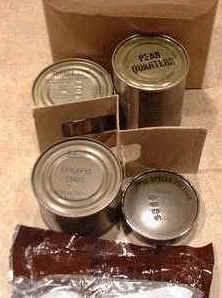 |
Yankee "Rat Packs" |
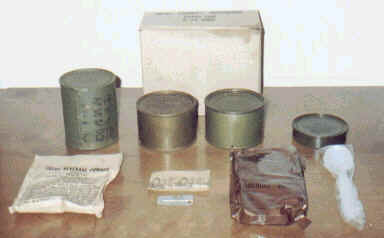 |
Since WW2 most of the
integration that the Australian Army has had to do is with the Yanks. In
Korea and Viet Nam that meant that sometimes Aussies had to eat the
American C Rations. I am told by usually reliable sources that they are
better than starving to death, but not much. Generally the American
stuff was/is too bland and soft for Australian tastes. This belief may
be supported by the fact that many unofficial recipes for C-Ration meals
call for the addition of Tabasco Sauce, an item not usually found in an
Australian Diggers basic pouch in the 1950s or 1960s, although I am told
that these days it is included in the new packs
| C-rations were designed to be eaten cold, but they tasted
better hot. And nothing heated as fast as a small nugget of C4 blasting
compound set afire with the end of a cigarette. |
|
| C
Rations in Korea |
|
We Eat C Rations after Landing
Well we have landed and the company has been assembled. C
Rations have been issued and we are having something to eat. C Rations
is a box about 5 by 10 inches with food for one person for three meals.
Nutritious but not exactly exciting. The company has an immersion
heater. That is a heater that is gas fired and dropped in a garbage can
of water. When the water is boiling, soldiers tie wires around their
cans of food and lower it into the boiling water to warm their food. It
is best to hang on to your wire less some other rescue your food.
Otherwise you gum down the can of food with the coagulated grease, or in
freezing weather try to thaw it out in your mouth, that is after you
carve it out of the can with your bayonet. Most of these rations were
left over from WWII. We referred to the food as "has beans."
Many of the Korean civilians were starving and scrounged the discarded
cans for remaining food. We often gave boxes to some of the deserving kids.
from http://www.paulnoll.com/Korea/581-Sig/581-Inchon-chow.html
|
| C-Rations used in Vietnam |
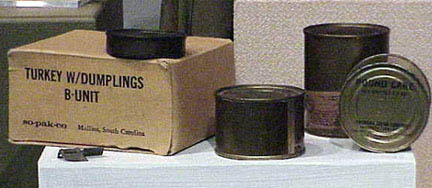 |
This is the official US
Quartermaster's
description of C-Rations used in Vietnam |
"The Meal, Combat, Individual,
is designed for issue as the tactical situation dictates, either in
individual units as a meal or in multiples of three as a complete ration.
Its characteristics emphasize utility, flexibility of use, and more
variety of food components than were included in the Ration, Combat,
Individual (C Ration) which it replaces. Twelve different menus are
included in the specification.
Each menu contains: one canned
meat item; one canned fruit, bread or dessert item;
one B unit; an accessory packet
containing cigarettes, matches, chewing gum, toilet paper, coffee, cream,
sugar, and salt; and a spoon. Four can openers are provided in each case
of 12 meals. Although the meat item can be eaten cold, it is more
palatable when heated.
Each complete meal contains
approximately 1200 calories. The daily ration of 3 meals provides
approximately 3600 calories."
|
B-1 Units
Meat Choices (in
small cans):
Beef Steak
Ham and Eggs,
Chopped
Ham Slices
Turkey Loaf
Fruit:
Applesauce
Fruit
Cocktail
Peaches
Pears
Crackers (7)
Peanut Butter
Candy Disc, Chocolate
Solid
Chocolate
Cream
Coconut
Accessory Pack*
|
B-2 Units
Meat Choices (in
larger cans):
Beans and
Wieners
Spaghetti
and Meatballs
Beefsteak,
Potatoes and Gravy
Ham and
Lima Beans
Meatballs
and Beans
Crackers (4)
Cheese Spread, Processed
Caraway
Pimento
Fruit Cake
Pecan Roll
Pound Cake
Accessory Pack* |
B-3 Units
Meat Choices (in
small cans):
Boned
Chicken
Chicken and
Noodles
Meat Loaf
Spiced
Beef
Bread, White
Cookies (4)
Cocoa Beverage Powder
Jam
Apple
Berry
Grape
Mixed
Fruit
Strawberry
Accessory Pack* |
|
*Accessory Pack
Spoon, Plastic
Salt
Pepper
Coffee, Instant
Sugar
Creamer, Non-dairy
Gum, 2 Chicklets
Cigarettes, 4
smokes/pack
Winston
Marlboro
Salem
Pall
Mall
Camel
Chesterfield
Kent
Lucky Strike
Kool
Matches, Moisture
Resistant
Toilet Paper
|
FOX HOLE DINNER FOR TWO
(Turkey & Chicken Poulette)
1 can chicken and noodles
1 can turkey loaf, cut up into pieces
1 can cheese spread
12 spoons milk
Crackers from one C-Ration can, crumbled
Salt & pepper to taste
2 spoons butter or oil or fat-
2 spoons flour
3 dashes TABASCO
Melt butter oil
or fat, add flour and stir until
smooth. Add milk and continue to cook until cheese melts and sauce
is even. Empty cans of turkey loaf and chicken noodles into cheese
sauce.
Season with TABASCO,
salt & pepper to taste and continue cooking. Cover poulette
with crumbled crackers and serve piping hot. |
|
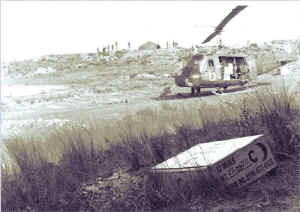 |
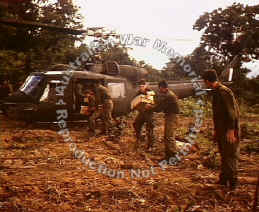
|
| Photo left. Maybe the food wasn't great
but you have to admit the delivery system was the best in the world.
This Huey is crammed full of C Rats. |
Photo right.
Phuoc
Tuy Province, South Vietnam. 24 August 1967. Troops from C Company, 7th
Battalion, The Royal Australian Regiment (7RAR), unload a resupply RAAF
Iroquois helicopter at their base near the village of Long Dien. In the
back of the Huey are stacked C rations, American pack rations. |
|
The Army's Best Invention |
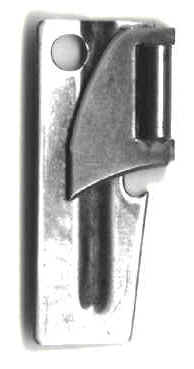 |
The Folding Can Opener
The P38
Story by Maj. Renita Foster |
It was developed in just 30 days in the summer of 1942 by the
Subsistence Research Laboratory in Chicago. And never in its
52-year history has it been known to break, rust, need
sharpening or polishing. Perhaps that is why many soldiers, past
and present, regard the P-38 C-ration can opener as the Army's
best invention.
C-rations have long since been replaced with the more convenient
Meals, Ready to Eat (MREs), but the fame of the P-38 persists,
thanks to the many uses stemming from the unique blend of
ingenuity and creativity all soldiers seem to have.
"The P-38 is one of those tools you keep and never want to
get rid of," said Sgt. Scott Kiraly, a military policeman.
"I've had my P-38 since joining the Army 11 years ago and
kept it because I can use it as a screwdriver, knife,
anything. "The most vital use of the P-38, however, is the very mission it
was designed for, said Fort Monmouth, N.J., garrison commander
Col. Paul Baerman. "When we had C-rations, the P-38 was
your access to food; that made it the hierarchy of needs,"
Baerman said. |

|
"Then soldiers discovered it was an extremely
simple, lightweight, multipurpose tool. I think in warfare, the
simpler something is and the easier access it has, the more
you're going to use it. The P-38 had all of those things going
for it."
The tool acquired its name from the 38 punctures required to
open a C-ration can, and from the boast that it performed with
the speed of the World War II P-38 fighter plane.
"Soldiers just took to the P-38 naturally," said World
War II veteran John Bandola. "It was our means for eating
90 percent of the time, but we also used it for cleaning boots
and fingernails, as a screwdriver, you name it. We all carried
it on our dog tags or key rings." When Bandola attached his
first and only P-38 to his key ring a half century ago, it
accompanied him to Anzio, Salerno and through northern Italy. It
was with him when World War II ended, and it's with him now.
"This P-38 is a symbol of my life then," said Bandola.
"The Army, the training, my fellow soldiers, all the times
we shared during a world war."
Sgt. Ted Paquet, swing shift supervisor in the Fort Monmouth
Provost Marshal's Office, was a 17-year-old seaman serving
aboard the amphibious assault ship USS New Orleans during the
Vietnam war when he got his first P-38. The ship's mission was
to transport Marines off the coast of Da Nang.
On occasional evenings, Marines gathered near Paquet's duty
position on the fantail for simple pleasures like "Cokes,
cigarettes, conversation and C-rations." It was during one
of these nightly sessions that Paquet came in contact with the
P-38, or "John Wayne" as it's referred to in the Navy.
Paquet still carries his P-38, and he still finds it useful.
While driving with his older brother, Paul, their car's carburettor
began to have problems. "There were no tools in
the car and, almost simultaneously, both of us reached for P-38s
attached to our key rings," Paquet said with a grin.
"We used my P-38 to adjust the flow valve, the car worked
perfectly, and we went on our merry way."
Paquet's P-38 is in a special box with his dog tags, a
.50-caliber round from the ship he served on, his Vietnam
Service Medal, South Vietnamese money and a surrender leaflet
from Operation Desert Storm provided by a nephew. "It will
probably be on my dresser until the day I die," Paquet
said.
The feelings veterans have for the P-38 aren't hard to
understand, according to 1st Sgt. Steve Wilson of the Chaplain Centre
and School at Fort Monmouth. "When you hang on to
something for 26 years," he said, "it's very hard to
give it up. That's why people keep their P-38 just like they do
their dog tags.... It means a lot. It's become part of you. You
remember field problems, jumping at 3 a.m. and moving out. A
P-38 has you reliving all the adventures that came with
soldiering in the armed forces. Yes, the P-38 opened cans, but
it did much more. Any soldier will tell you that."
|
|
How to make a C-Ration Stove |
 The
small cans included in the meal were ideal for making a stove. Using a
"John Wayne" pierce a series of closely spaced holes around
the top and bottom rims of the can. This stove was satisfactory, but did
not allow enough oxygen to enter which caused incomplete burning of the
blue Trioxin heat tablet, causing fumes which irritated the eyes
and respiratory tract. A whole heat tab had to be used. The
small cans included in the meal were ideal for making a stove. Using a
"John Wayne" pierce a series of closely spaced holes around
the top and bottom rims of the can. This stove was satisfactory, but did
not allow enough oxygen to enter which caused incomplete burning of the
blue Trioxin heat tablet, causing fumes which irritated the eyes
and respiratory tract. A whole heat tab had to be used.
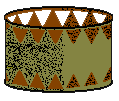 A
better stove was created by simply using the can opener end of a
"church key" (a flat metal device designed to open soft drink
and beer containers with a bottle opener on one end and can opener on
the other commonly used before the invention of the pull tab and
screw-off bottle top) to puncture triangular holes around the top and
bottom rims of the can which resulted in a hotter fire and much less
fumes. With this type of stove only half a Trioxin heat tab was needed
to heat the meal and then the other half could be used to heat water for
coffee or cocoa. A small chunk of C-4 explosive could also be
substituted for the Trioxin tablet for faster heating. It would burn
hotter and was much better for heating water. A
better stove was created by simply using the can opener end of a
"church key" (a flat metal device designed to open soft drink
and beer containers with a bottle opener on one end and can opener on
the other commonly used before the invention of the pull tab and
screw-off bottle top) to puncture triangular holes around the top and
bottom rims of the can which resulted in a hotter fire and much less
fumes. With this type of stove only half a Trioxin heat tab was needed
to heat the meal and then the other half could be used to heat water for
coffee or cocoa. A small chunk of C-4 explosive could also be
substituted for the Trioxin tablet for faster heating. It would burn
hotter and was much better for heating water.
.
A stove was usually carried in
the back pack or cargo pocket and used repeatedly until the metal began
to fail.
Australian troops were always issued
with hexamine stoves and so did not have to create this type.
|
|
US Operational Rations in World War
II
As a result of these developments, the
Army entered World War II with two established special-purpose
rations-Field Ration D and Field Ration C. Ration D (see
below) was used throughout
the war as the Army's emergency ration and as a supplement to other
rations. The C ration went through an evolution which ultimately
produced an outstanding ration for the purpose it was designed to meet-a
daily food which the soldier could carry and use when he was cut off
from regular food supply sources.
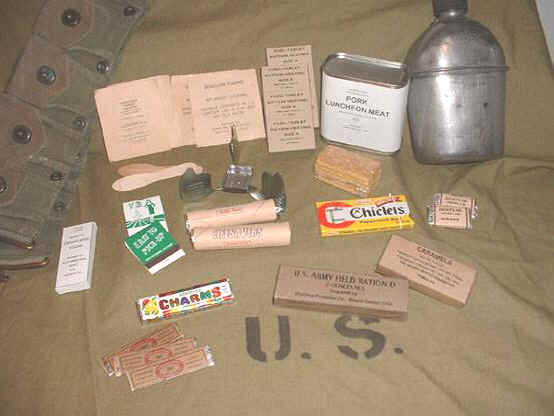
The use of these rations after 1941
revealed their inability to meet all the many feeding problems imposed
by new combat conditions. Therefore, a succession of rations, individual
food packets, and ration supplements was developed and came into use
before the war's end. The haste attached to the initial wartime ration
development indicated that the country was no better prepared to cope
with the food problem in 1941 than with other problems of war supply.
The early trial-and-error method was proof, too, that haste made waste.
Nevertheless the food program ultimately evolved for the American
soldier was firmly based on the premise-"that all troops . . . be
fed the best food available in the best and most appetizing form within
the realm of reasonable possibility particularly . . . troops in
combat." 31 For the citizen soldier, for the most part accustomed
to good food in civilian life, "what do we eat" became as
important, if not more so, than "when do we eat." In addition
to providing an acceptable answer to this query, ration developers had
to pay equal attention to military utilization, to stability and storage
requirements, to nutritional values, to demands for shipping space, and
to the necessity of going beyond commercial practices to protect
packaged foods on the long journey from American factories to theatres of action. Add factors of war born shortages of material and the
continued necessity for providing adequate interim substitutes and the
magnitude of the ration-development problem in World War II becomes
evident.
Despite obstacles, many varied and
excellent rations, packets, and supplements were developed and supplied
to the World War II soldier. In volume, approximately one billion
special rations, costing about 675 millions of dollars, were procured
between 1941 and 1945 (see table 1).
The list includes such individual
rations as the lightweight K ration, the emergency D ration, and the
food-for-a-day C ration. Need of rations in specific climates produced
the mountain, jungle, and desert rations. Packets produced for
subsistence requirements in flight were an aircrew lunch, a
parachute-emergency packet, and an in-flight combat meal. At-sea
survival called for lifeboat and life raft rations and pointed to the
desirability of all-purpose survival foods. Supplements were designed to
augment other rations:
namely, the aid-station and hospital
beverage packs that provided beverages for casualties at advance medical
posts, and the kitchen spice pack for use by mobile kitchens. At the end
of the war, the assault packet, intended to provide a quick-energy snack
before combat, was in production.
http://www.qmmuseum.lee.army.mil/index.html |
other details from several American sites
|